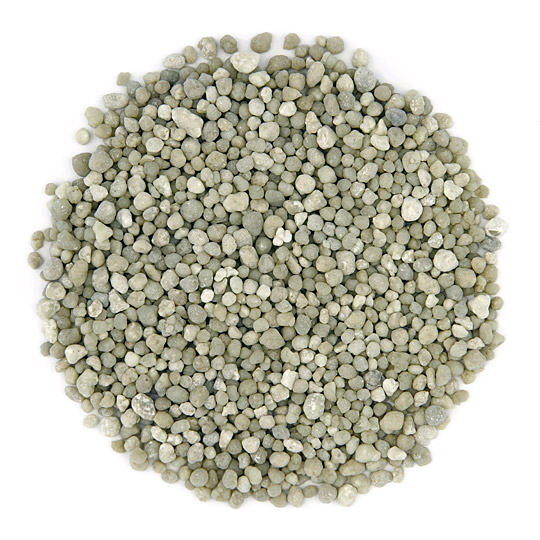Diammonium Phosphate (DAP)

Technical specification
Diammonium phosphate (DAP or diammophos) is a complex, highly concentrated, granular mineral fertilizer with excellent physical properties. It contains two main nutrients in its composition — 18% nitrogen (N) and 46% phosphoric pentoxide (P2O5) or in total 63% of active substance. It is obtained through a reaction between phosphoric acid (P2O5) and ammonia (NH3). It is incompatible with other alkaline chemicals due to the fact that its ammonium ions turn into ammonia when they get into medium with higher рH. This product of high quality is easily input into the soils, it is highly soluble, it is not hygroscopic and has a granular form with equal in size granules, which is evenly dissipated along the soil surface.
Diammonium phosphate is used for pre-sowing fertilization of winter and spring crops under irrigation conditions. It is suitable for fertilization of soils rich in potassium. Because of the fact that it is water-soluble, it has the properties of fast-acting phosphorus fertilizer, and the low mobility of the phosphorus in the soil allows its use for main, stocking as well as for periodic fertilization. No additional pre-sowing fertilization with nitrogen is needed in autumn crops.
It may be applied directly into the soil with the help of conventional equipment for spraying.
It is stored in well ventilated, cool and dry storehouse premises which do not allow for moistening or direct sun heating.
Heating, leaving it in the open air, mixing with water or with strong bases and with sodium hypochlorite should be avoided.
It is transported packaged or in bulk. Agropolychim AD offers diammonium phosphate in packages of vent cassette bags of polythene and prolypropylene, in bags of 50 kg, 500 kg and 1000 kg.
Advantages
- It satisfies the needs for balanced input of nutrients depending on the contents of their absorbable forms in the soil;
- It prevents the lack of nitrogen and provides permanent and complete fermentation. The high contents of phosphorus assist the accumulation of sugar in root crops and fruits;
- It increases the endurance of the plants to unfavourable factors (drought, cold/frost), and it increases their endurance to diseases
- It maintains the balance between the vegetative and reproductive phase;
- It reduces the expenditures for storage, transportation and input into the soil.
Customs tariff number
3105300000
Technical characteristics
| PARAMETER | NORM | Harmonized analytical standard | |||||
| Total Nitrogen (N), % | 18,0 ± 1.5 | BDS EN 15750 | |||||
| Ammoniacal Nitrogen, % | 18,0 ± 1.5 | BDS EN 15475 | |||||
| Total Phosphorus pentaoxide (Р2О5), % | 46,0 ± 1.5 | BDS EN 15956 ; BDS EN 15959 | |||||
| Phosphorus pentoxide (P2O5), soluble in neutral ammonium citrate, % | 46.0 ± 1.5 | BDS EN 15957; BDS EN 15959 | |||||
| Phosphorus pentoxide (P2O5), soluble in water, % | 42.0 ± 1.5 | BDS EN 15958; BDS EN 15959 | |||||
| Content of water*, % | max 2.0 | BDS EN 13466-1 | |||||
| Cadmium (Cd)*, mg/kg Р2О5 | max 60 | BDS EN 16319 + А1 | |||||
| Hexavalent Chromium (Cr VI)*, mg/kg dry matter | max 2 | BDS EN 16318 + А1 | |||||
| Mercury (Hg)*, mg/kg dry matter | max 1 | BDS EN 16320 + А1 | |||||
| Nickel (Ni)*, mg/kg dry matter | max 100 | BDS EN 16319 + А1 | |||||
| Lead (Pb)*, mg/kg dry matter | max 120 | BDS EN 16319 + А1 | |||||
| Arsenic (As)*, mg/kg dry matter | max 40 | BDS EN 16317 + А1 | |||||
| Granulometry: granules 1-5 mm | min 98 | BDS EN 1235 | |||||
* Parameters are not required for labeling according to Regulation 2019/1009 of EU fertilizing products. Determined at request and once / 3 months.